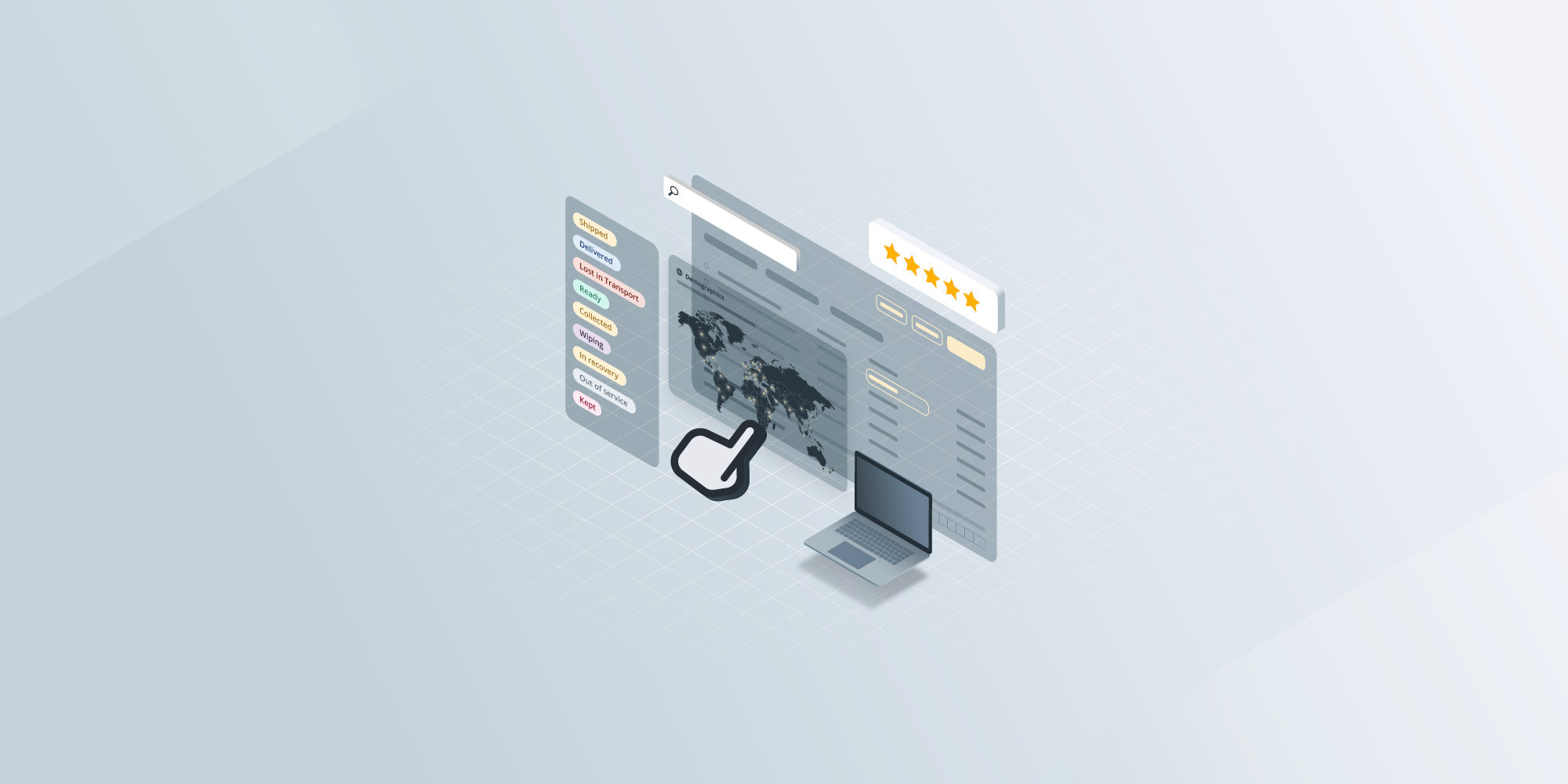IT asset lifecycle management: The ultimate guide for 2025
 Mara Quintanilla
Mara Quintanilla
Managing IT assets with spreadsheets is no longer compatible with today's flexible work environment. A manual asset management system might still work for on-premise businesses, but in distributed environments where devices are located in different countries, IT asset management becomes vital.
Companies nowadays need to take care of their assets from wherever their team is located. IT asset lifecycle management is the process that makes this possible, allowing businesses across industries to keep equipment healthy and running smoothly. The IT asset lifecycle management process enables organizations to manage their IT assets throughout their entire lifecycle, from procurement and planning to retirement and decommissioning.
In this article, we will take a closer look at the importance of IT asset management for distributed teams, how asset management can benefit business efficiency, and some best practices.
What is the IT asset lifecycle?

The IT asset lifecycle is a comprehensive process encompassing the management of IT assets from their purchase until their disposal. Companies need effective asset lifecycle management to maximize the value of their assets while minimizing costs and risks.
The IT asset lifecycle includes several stages that ensure that hardware and software assets are efficiently managed throughout their useful life and aligned with the organization’s strategic goals. The process has the following stages:
- Planning
- Acquisition
- Deployment
- Utilization
- Maintenance
- Disposal
To manage the entire asset life cycle, companies use paid IT asset management software solutions or free IT asset management software. A robust asset management lifecycle software can help organizations track existing assets and maintain an accurate inventory thanks to real-time tracking features and actionable insights available from a central console.
A key aspect of asset life cycle management is tracking software licenses. Taking care of the software asset management lifecycle helps maintain asset performance and compliance with relevant regulations. Asset lifecycle management software helps conduct regular audits, roll out necessary updates, and provide ongoing maintenance.
IT asset management lifecycle practices also help organizations make informed decisions regarding their IT investments. By evaluating existing IT systems and forecasting future requirements, asset managers can plan for new acquisitions and avoid unnecessary purchases.
Knowing when asset maintenance is due and monitoring an asset's life and usage help ensure compliance with organizational policies, thus mitigating risks and preventing data loss.
Good asset lifecycle management can ultimately lead to significant cost savings. Optimizing the use of software and hardware assets helps organizations know the total cost of ownership for each asset. Overall, effective asset life cycle management improves operational efficiency.
Stages of IT asset lifecycle management

Each stage of the asset lifecycle management process helps your organization's IT team tackle all the elements we mentioned above in an organized way. Here's a breakdown of what each stage involves:
Procurement / Planning
Planning is essential for effective procurement. These two concepts go hand in hand, as companies must identify their needs and plan to procure accordingly. The IT procurement and planning stage involves budgeting, forecasting, and determining the right vendors. Planning will make it easier to make better purchasing decisions based on the costs and benefits of different assets.
Deployment
Once the assets are procured, they are deployed to the appropriate users. This stage involves setting up, configuring, and installing the assets and training users on how to use them. Ensuring that assets are deployed to the right users, configured, and set up correctly to ensure optimal performance is vital for easy operations within companies.
Operation & maintenance
After assets are deployed, they enter the operation and maintenance stage. This is where the organization ensures that the assets are in good working condition and that they are being used properly. Regular maintenance and monitoring are necessary to ensure that assets function correctly and any issues are identified and resolved quickly. Companies can stay ahead of trouble by having a preventive maintenance checklist in place.
Support
When assets get older, they require additional support. This stage involves providing helpdesk and technical support to users and troubleshooting to resolve any issues. It's important that users can access the support they need so they can use and maintain their assets effectively.
Retirement & decommissioning
Eventually, assets will end their useful life and need to be retired. This stage involves decommissioning assets and disposing of them in an environmentally friendly manner. It is essential to ensure that retired assets are correctly disposed of and that sensitive data is securely erased.
Why is IT asset lifecycle management important for distributed companies?
IT asset lifecycle management is complex for distributed companies that lack a central office from which all devices can be tracked and managed. Companies must turn to technology to ease the burden on their IT teams of keeping tabs on all company equipment.
When your employees are spread across the globe, you need complete visibility of each asset's location and status in case a device goes missing or needs to be repaired.
Asset life cycle management solutions can help remote companies improve their IT asset management by providing a systematic approach to procurement, deployment, operation, maintenance, support, and retirement.
Aside from keeping devices in good working condition, the reasons for remote companies to have an asset lifecycle management process in place can range from cutting costs to increasing efficiency.

Cost savings
Organizations can reduce costs associated with purchasing, deploying, and maintaining IT assets by incorporating effective asset management. Companies can avoid unnecessary spending by tracking assets and identifying those that are no longer needed.
Improved security
Adequate management of tech assets can help organizations improve security by ensuring that assets are correctly configured, that security software is up-to-date, and that sensitive data is securely erased before assets are retired.
Increased efficiency
Effective asset management helps organizations ensure that their devices are used efficiently and that users can access the assets they need to perform their work. This can lead to increased productivity and efficiency.
What are the benefits of remote IT asset lifecycle management?
Having visibility over the entire lifecycle of your corporate devices can help your organization's leadership make informed decisions over their IT environment. Here are some of the benefits of having granular control over your asset lifecycle management:
Lower costs
IT asset lifecycle management software can help you reduce costs by automating manual tasks and eliminating the need for physical staff. This will free up resources that can be reallocated to more critical projects.
Improved visibility into your inventory
You'll better understand how many assets you have and where they are located, which will help you plan for future needs and avoid costly mistakes.
Faster deployment times
It also enables you to deploy new equipment faster, so your business can get back on track quickly when equipment fails or needs replacing.
Increased flexibility
By managing assets remotely, organizations can send devices to onboard employees or pick up equipment from employees who are leaving, regardless of location. This can lead to increased flexibility and improved ability to scale quickly.

Best practices for IT asset lifecycle management
To ensure that your IT assets are managed efficiently throughout all stages involved in their lifecycle, follow these best practices:
Regular audits
Regular auditing of your IT assets can help you identify issues and ensure that assets are being used efficiently. It can also help you identify assets that are no longer needed so you can retire them and reduce costs.
Automation tools
These tools can help you streamline your tech asset management process by tracking, scheduling maintenance, and generating reports.
Monitor KPIs
Stakeholders and decision-makers can make data-driven decisions by having regular performance reports. They will be able to determine whether the changes have positively affected the company operations, identify areas for improvement, and ensure goals are being met.
Keep stakeholders in the loop
IT managers, network administrators, and other staff members need to be kept in the loop throughout the entire process of effectively managing your IT assets. Communicating with these stakeholders regularly ensures that everyone is on board with your plans for managing assets and that any changes can be quickly implemented.
Proper documentation
By keeping accurate and up-to-date records of your purchases, you can ensure that you have a complete and precise inventory, which can help you manage your budget and make better business decisions.

GroWrk's IT asset lifecycle services
GroWrk offers comprehensive IT asset lifecycle services to optimize your IT assets from the acquisition stage to disposal. Our asset management software supports data-driven decisions, helping you forecast IT needs, manage budgets, and avoid unnecessary purchases.
Our asset management software simplifies asset procurement, ensuring you get the best value. We handle software and hardware assets seamlessly with mobile device management, supporting asset tracking from onboarding to maintain an accurate inventory.
GroWrk ensures full utilization and optimal performance of IT assets by managing software licenses, performing updates, and preventing data loss. When assets reach the end of their lifecycle, we handle secure and sustainable disposal, including data sanitization and compliance with environmental standards.
With GroWrk’s asset lifecycle management software, you gain real-time visibility and control over your IT assets. Our services enhance operational efficiency, support strategic decision-making, and maximize your IT investments for business value.
GroWrk’s platform implements asset lifecycle management best practices, ensuring that your IT environment is always optimized. Our software tools help manage asset lifecycles effectively, providing relevant data to meet your business needs. We offer the best asset lifecycle management solutions to enhance your operational capabilities and achieve sustained success. Choose GroWrk to manage your IT assets efficiently and support your organization’s growth and success.
Conclusion
Many companies struggle to manage their IT assets as work flexibility becomes the new normal. IT asset management lifecycle solutions provide a systematic approach to procuring, deploying, operating, maintaining, supporting, and retiring software and hardware assets that streamline device management workflows for distributed IT teams.
Improving efficiency, reducing costs, and increasing flexibility are a few ways asset lifecycle management software can transform business operations in distributed companies.
If your organization is looking for a solution to manage IT assets for distributed teams, we can help. We set up, equip, and scale remote companies while managing the full IT asset lifecycle. Our powerful dashboard gives you complete visibility over your assets so you can focus on what’s important. Request a demo today to experience streamlined and unlimited growth.
FAQs
What is IT asset lifecycle?
IT Asset Lifecycle refers to an asset's stages, from procurement to retirement. It includes procurement, asset deployment, operation, maintenance, support, and retirement stages.
What are the benefits of following the asset lifecycle management process?
Following an IT Asset Lifecycle Management process can provide several advantages, such as cost savings, improved security, increased efficiency, reduced IT costs, increased flexibility, and enhanced ability to scale quickly.
What is the purpose of IT asset lifecycle management?
IT Asset Lifecycle Management aims to effectively manage and maintain an organization's IT assets throughout its entire lifecycle, from procurement and planning to retirement and decommissioning. This includes budgeting, forecasting, identifying the right vendors, setting up, configuring, installing, training users, monitoring, providing helpdesk and technical support, troubleshooting, resolving issues, and decommissioning assets securely.
What are the four phases of the asset lifecycle?
The four main phases of the asset lifecycle are procurement and planning, deployment, operation and maintenance, and retirement and decommissioning. However, the four life cycle phases can be divided into more specific steps depending on the asset or a company’s needs.
How can IT asset lifecycle management improve compliance?
IT Asset Lifecycle Management can improve compliance with regulatory requirements by ensuring that all IT assets are properly configured and maintained and that restricted data is securely erased before assets are retired. This can involve implementing security best practices, such as regular audits and software updates, and ensuring that all purchases are adequately tracked and inventoried. Additionally, it can help organizations meet regulatory requirements by providing that they have accurate records of their IT assets and can quickly respond to audits or security incidents.







